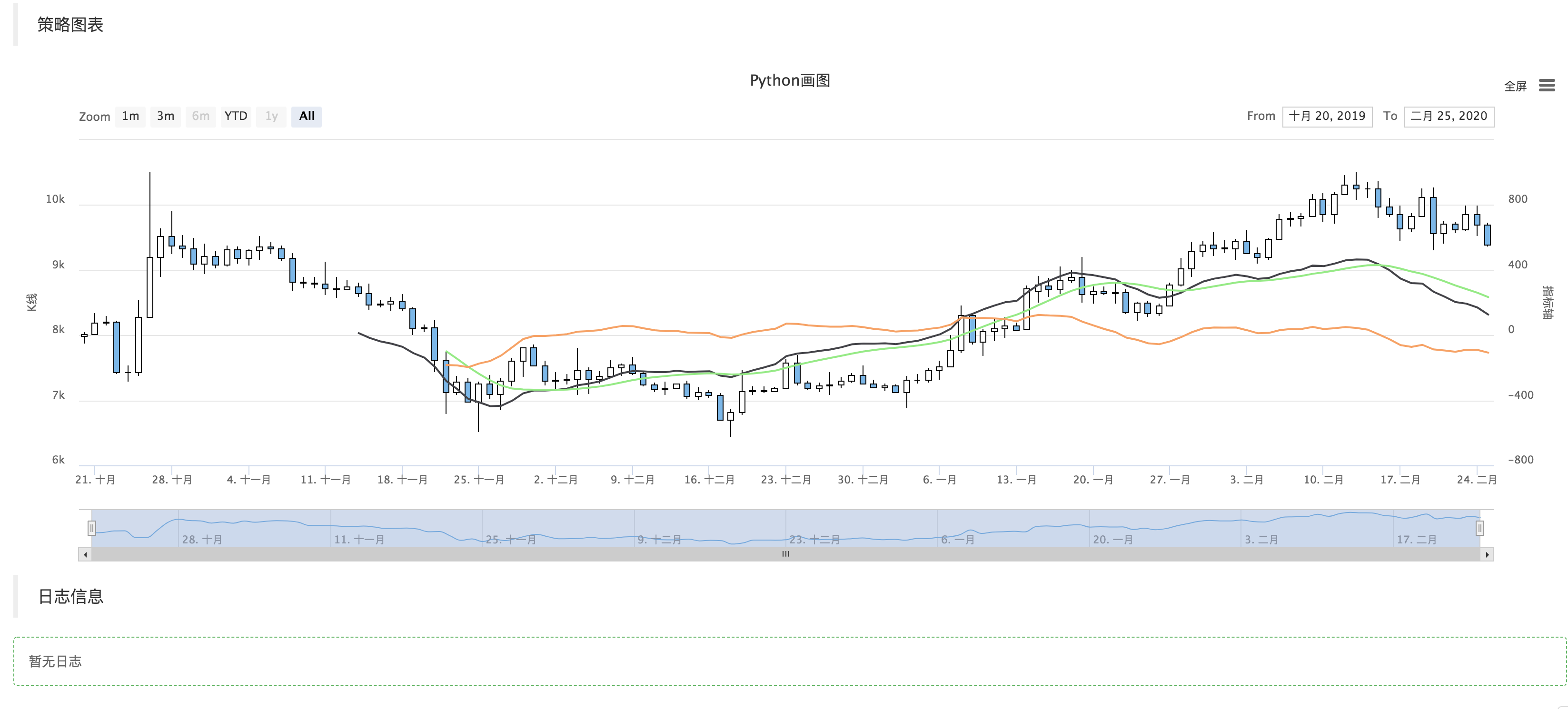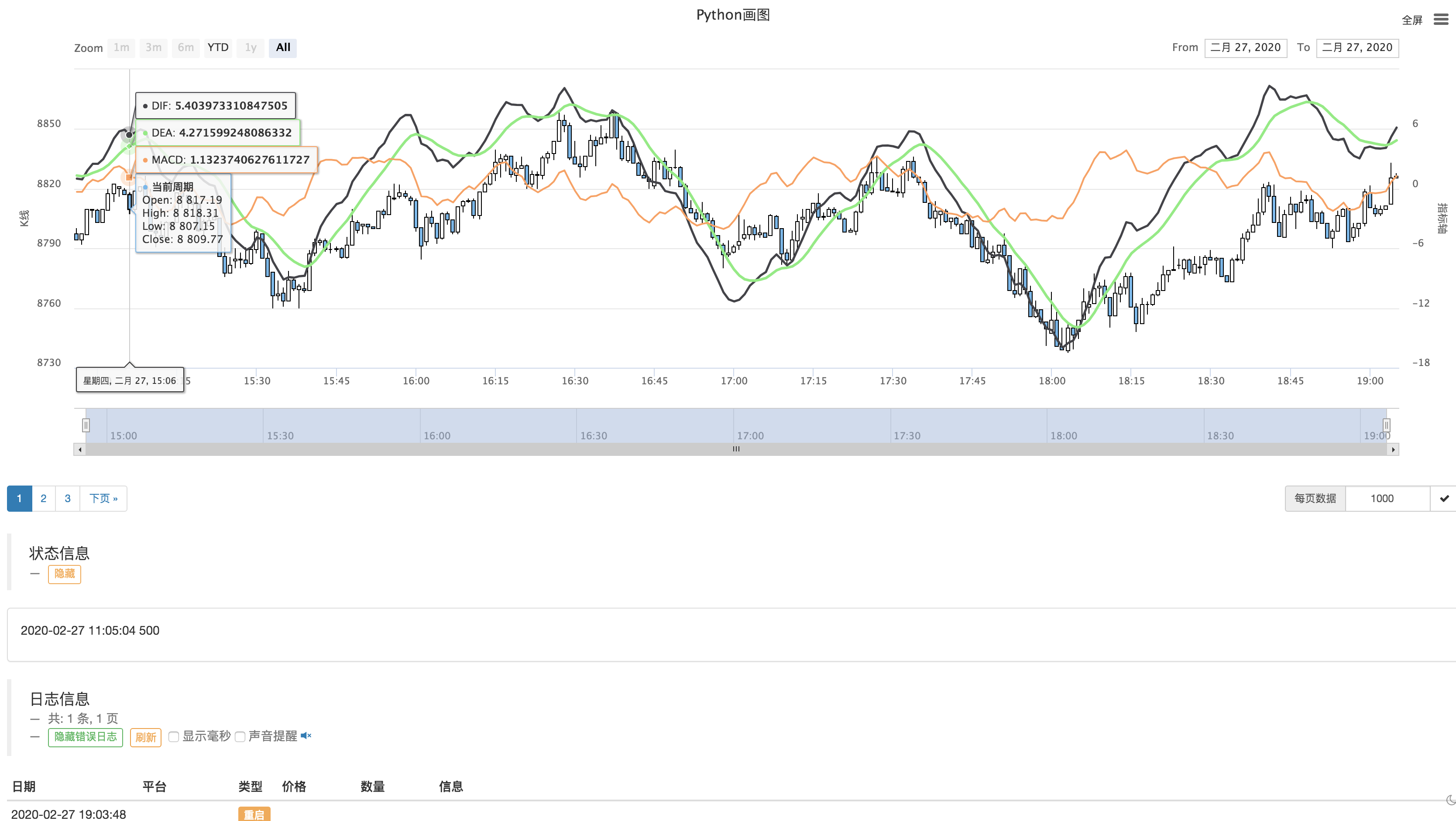Python version of the MACD graph example
Author: The Little Dream, Created: 2020-02-27 19:18:17, Updated: 2023-10-09 22:50:01
Python version of the MACD graph example
In fact, before doing this example code, the inventors quantified the trading platform strategy in Square:https://www.fmz.com/strategy/151972There are already examples of MACD pointer diagrams in JavaScript. However, the user needs to write a Python version of the example to be used as reference code when developing a design diagram.
The code is very simple:
'''backtest
start: 2020-01-28 00:00:00
end: 2020-02-26 00:00:00
period: 1d
exchanges: [{"eid":"OKEX","currency":"BTC_USDT"}]
'''
ChartCfg = {
'__isStock': True,
'title': {
'text': 'Python画图'
},
'yAxis': [{
'title': {'text': 'K线'},
'style': {'color': '#4572A7'},
'opposite': False
}, {
'title': {'text': '指标轴'},
'opposite': True
}],
'series': [{
'type': 'candlestick',
'name': '当前周期',
'id': 'primary',
'data': []
}, {
'type': 'line',
'id': 'dif',
'name': 'DIF',
"yAxis" : 1,
'data': []
}, {
'type': 'line',
'id': 'dea',
'name': 'DEA',
"yAxis" : 1,
'data': []
}, {
'type': 'line',
'id': 'macd',
'name': 'MACD',
"yAxis" : 1,
'data': []
}]
}
def main():
global ChartCfg
preTime = 0
chart = Chart(ChartCfg)
chart.reset()
while True:
while True:
r = _C(exchange.GetRecords)
if len(r) > 50:
break
# 计算指标
macd = TA.MACD(r)
LogStatus(_D(), len(r))
# 画图
for i in range(len(r)):
if r[i]["Time"] == preTime:
chart.add(0, [r[i]["Time"], r[i]["Open"], r[i]["High"], r[i]["Low"], r[i]["Close"]], -1)
chart.add(1, [r[i]["Time"], macd[0][i]], -1)
chart.add(2, [r[i]["Time"], macd[1][i]], -1)
chart.add(3, [r[i]["Time"], macd[2][i]], -1)
elif r[i]["Time"] > preTime:
chart.add(0, [r[i]["Time"], r[i]["Open"], r[i]["High"], r[i]["Low"], r[i]["Close"]])
chart.add(1, [r[i]["Time"], macd[0][i]])
chart.add(2, [r[i]["Time"], macd[1][i]])
chart.add(3, [r[i]["Time"], macd[2][i]])
preTime = r[i]["Time"]
Sleep(500)
ChartCfg Chart configuration dictionary
This oneChartCfgA dictionary variable stores chart configuration information, such as:
How many lines are there in this graph? (three indicator lines, DIF, DEA, MACD)
Is there a K-line in this graph? (Candlestick type: This type is set to K-line data)
The MACD values are relatively small, and if the trading pair is BTC_USDT, the indicator will be compressed together when drawing the chart, so the chart will also be configured as two Y-axes.
Loading data
In this example strategy, the main function starts initializing the chart, calls the Chart function, configures the chart to ChartCfg as a parameter input, generates a chart object chart. Then goes into a loop, continuously obtaining K-line data, determining that the number of K-line data BAR is greater than 50 to calculate the MACD indicator (BAR is too small to calculate the valid indicator); then the K-line data and indicator data can be written to the chart. Write a method to a chart using the chart object add function. When writing, if the last parameter of the add function is specified -1, the value of the current data point is updated. If not passed -1, a new data point is added. When a new K-line BAR is generated, a new data point is added, and when a K-line BAR is not generated, the last BAR and the corresponding indicator are updated.
It can be directly measured.

It can also run on a hard disk:
The following is the address of the strategic example:https://www.fmz.com/strategy/187379
If you have any questions, thank you for leaving a message.
- Quantifying Fundamental Analysis in the Cryptocurrency Market: Let Data Speak for Itself!
- Quantified research on the basics of coin circles - stop believing in all kinds of crazy professors, data is objective!
- The inventor of the Quantitative Data Exploration Module, an essential tool in the field of quantitative trading.
- Mastering Everything - Introduction to FMZ New Version of Trading Terminal (with TRB Arbitrage Source Code)
- Get all the details about the new FMZ trading terminal (with the TRB suite source code)
- FMZ Quant: An Analysis of Common Requirements Design Examples in the Cryptocurrency Market (II)
- How to Exploit Brainless Selling Bots with a High-Frequency Strategy in 80 Lines of Code
- FMZ quantification: common demands on the cryptocurrency market design example analysis (II)
- How to exploit brainless robots for sale with high-frequency strategies of 80 lines of code
- FMZ Quant: An Analysis of Common Requirements Design Examples in the Cryptocurrency Market (I)
- FMZ quantification: common demands of the cryptocurrency market design instance analysis (1)